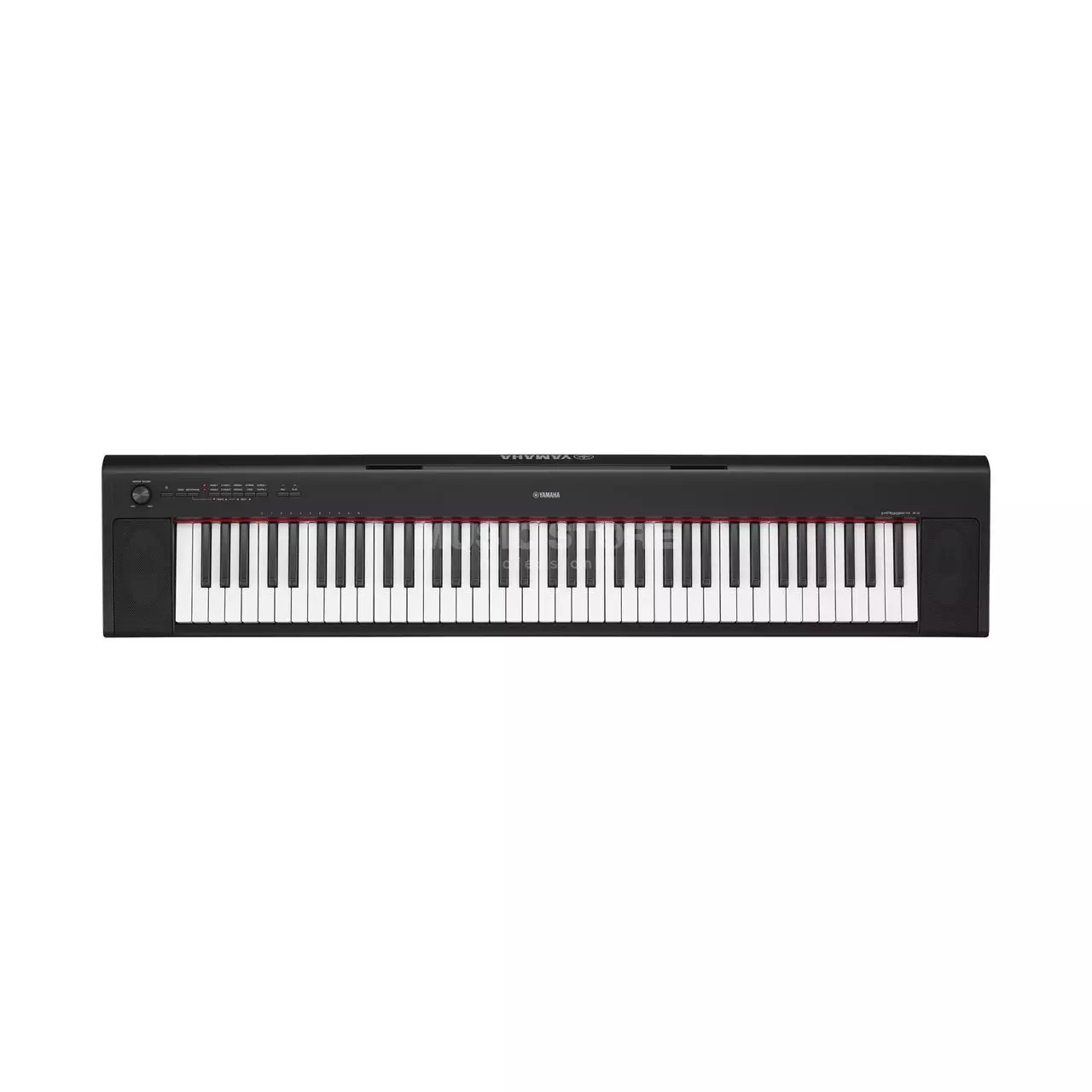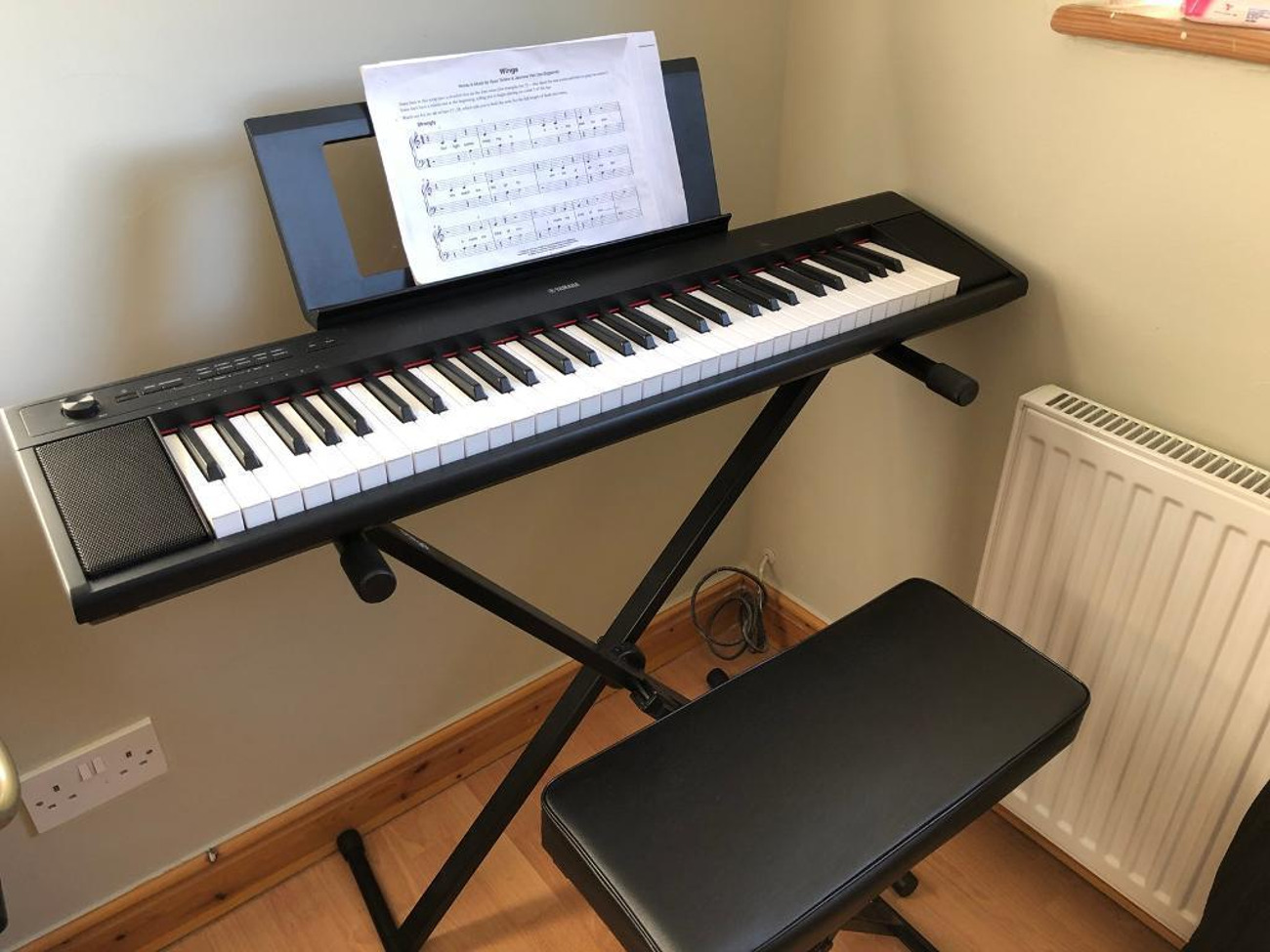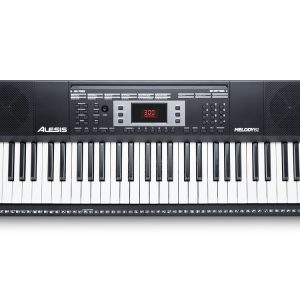Yamaha Piagerro NP32 Piano Review
We rated the Yamaha Piagerro NP32 7/10. This lightweight instrument is good for young students. However, we did have to take off some points due to the fact that the NP32 doesn’t have many connectivity options. Another big downfall of this model is that it just doesn’t make a great instrument to take on gigs. That being said, if you are in the market for an economical student-level piano to get your feet wet, this NP32 is a decent choice.
$300.00
We rated the Yamaha Piagerro NP32 7/10. This lightweight instrument is good for young students. However, we did have to take off some points due to the fact that the NP32 doesn’t have many connectivity options. Another big downfall of this model is that it just doesn’t make a great instrument to take on gigs. That being said, if you are in the market for an economical student-level piano to get your feet wet, this NP32 is a decent choice.
Overview

The Yamaha Piagerro NP32 is a 76-key digital piano. It’s the bigger version of the Piagerro NP12 which has 61 keys. The specs are very similar between these two keyboards with the main difference – apart from the number of keys – being the speaker output. The NP12 only has an output of 2.5 X 2.5W while the NP32 has a much bigger output of 6W X 6W. Neither keyboard has weighted keys, but the NP32 does have a “graded soft touch” which gives a sense of being able to play with some control over volume and expression.
At 12lb 9oz, the NP32 is extremely light and portable. If you need to move the keyboard from one room to another or take it on a trip, it’s light enough to do that with. However, it’s not a gigging instrument, being on the lower price point and not really built for a lot of useful connectivity. It’s really built with young piano students in mind – especially beginners. If you can’t get to an outlet, It can run for six hours on batteries.
Like the NP12, the design is sleek, with rounded edges. The buttons to find your sounds and functions are minimal and straightforward to use giving the keyboard a smooth, sophisticated look.
Like so many Yamaha keyboards, the functions are selected using a combination of buttons and the keys on the keyboard. It means looking up which keys you need to use to select certain functions until you start to know them. It’s a slightly clumsy way of doing it, but it means the front panel can remain uncluttered.
Keyboard
Although this keyboard doesn’t have weighted keys, it is touch-sensitive, meaning that you can control how soft and how loud you play. This is important for beginners as well as more experienced players.
Sound
For such a small, lightweight piano, the sound is excellent, especially considering the low price point. The pianos have been sampled from Yamaha’s best acoustic grand and the quality really comes across, particularly in the bass.
The sound on the NP32 is created with AWM (Advanced Wave Memory). The sounds are sampled digitally and then further digital technology layers realism in the way the notes decay. This gives a very responsive sound as different volume levels were recorded for more control and a more realistic playing experience.
Features
Voices
The NP32 has ten voices, which include two pianos sampled from Yamaha’s best acoustic piano. Other instruments include two electric pianos, two harpsichords, strings, and vibes. These are the same exact instruments as the NP12, but because the speaker system is a lot more powerful, the sound is richer and warmer.
The electric piano 1 has a lovely warm 80’s vibe to it while piano 2 is mellow and slightly more sophisticated. The pipe organs are pretty good for a keyboard of this level. The strings are quite good and fairly warm sounding. (It’s really difficult to find truly good strings on any keyboards. Any professional musician needing strings would turn to VST instruments and run them through a DAW (Digital Audio Workstation) on their computer).
Demo songs
There are 10 voice demo songs – one to demonstrate each of the different instruments. Songs included are Bach’s First Prelude, Mozart’s Turkish March, Haydn’s Little Serenade, and Moments Musicaux op.94 by Schubert. By using the metronome button you can change the speed of the demo songs which allows you to play along at a slower tempo if you want to play along with them.
There are also 10 onboard piano songs that you can enjoy listening to and even play along with.
Recording
The NP32 has a recording capability of 1 song, 1 track, with a maximum of 7,000 notes. It’s a really good idea to record yourself playing, especially when you’ve learned a new song. When we are playing the piano it can be difficult to assess our performance. By recording yourself and listening back, you’ll hear all kinds of things that you didn’t notice while you were playing. This is a really good practice tool for beginners and intermediates as well as advanced pianists. When you start to learn a new piece you can record one hand and then play it back and play along with the other hand – duetting with yourself in effect. Also, you can use the recording capability to capture improvisation and composition ideas.
Speakers
The Yamaha Piagerro NP32 has a 6 X 6 speaker system. This is plenty for a beginner or intermediate player in a small to medium room. If a child is going to have a practice keyboard in their bedroom, this would be more than enough.
Reverb and effects
The NP32 has a reverb effect for giving your music an intimate room sound or a big concert hall vibe. This setting can be set between 0 and 10 depending on your preference. The choices are Room, Hall 1, Hall 2, Stage, or Off.
Transpose
You can transpose by an octave. You can also transpose up or down by semitones from -6 to +6. This can be useful if you want to play a song in a different key – perhaps for a singer – but you’ve learned to play the song in the original key. If the singer wants the key to be two tones higher, for instance, you can select the “Transpose” button and set the key 4 semitones higher.
Fine Tuning
The Yamaha Piagerro NP32 can be detuned by 0.2Hz. This can be useful if you’re playing with a recording that isn’t quite in tune with your piano or playing with another performer who is playing an instrument that doesn’t quite get in tune. The setting range is 414.8–466.8Hz (=A3) Default setting: 440.0Hz (=A3).
Metronome
There is a metronome on board that can be set from 32 to 280 BPM. Using a metronome when practicing can help a student to develop a good sense of rhythm and the ability to keep time.
Dual Mode
You can combine two different instruments and have them sound together as you play. For instance, you might want to combine Piano 1 with Strings. It’s easy to set up, and with the push of a button you can turn one of the voices off as you continue to play. This can give a bit of variety to a song when you repeat a verse or chorus section. Note that you can’t layer two pianos or two harpsichords, only two different types of instruments.
Connectivity
There is a pedal jack for the sustain pedal and a USB so you can connect the keyboard to your computer. You can also use the USB to connect a phone or pad to the keyboard so that you have access to certain lesson apps.
Specifications

- 76 key piano action with Graded Soft Touch
- 4 types of touch sensitivity
- AWM sampling
- 10 voices, each with a demo a song
- 10 onboard piano songs
- Recording capability for 1 song, 1 track
- 64 note polyphony
- Damper pedal jack which, when used with the recommended pedal supports the half-pedal function
- USB TO HOST and headphone jack
Who Is It Suitable For?
Beginner
I like this keyboard for a beginner more than the NP12 for the fact that it has 76 keys and a bigger more realistic piano sound. The weight is sturdier too. Sometimes a very lightweight keyboard that’s on an X stand will slide around easily making it a bit of danger around children. Like the NP12, the price is extremely affordable to get started to see if the student is going to take to the piano or not.
It’s worth $100 more to get the bigger sound and may be more inspiring than the smaller keyboard. The portability means there’s no excuse not to practice as you can easily carry the keyboard to a quieter part of the house and as it can run on batteries for up to six hours, you don’t even need an outlet. If you go on vacation, it will come with you on a camping trip!
The piano sound on the NP32 is more than good enough for a beginner or even an early intermediate. The recording option is also excellent for beginners – but most keyboards have this capability anyway. The connectivity is somewhat limited, also indicating that this is a keyboard aimed at beginners.
Experienced and serious pianists
Any experienced pianist is going to require fully weighted keys – and 88 of them. However, this keyboard could be used as a spare or practice keyboard. It could also be used as a MIDI controller, but there are better options out there for that use. The limited amount of recording capability would likely be another problem for an advanced pianist who wants to record their performance or practice session.
Pros and Cons

Pros
- Extremely light and portable
- Pretty good sound for the price point
Cons
- No Split mode
- Unweighted keys
Quick View
| Keys | Non-weighted keys but “Graded soft touch” |
| Touch sensitivity | 4 settings: Hard, Medium, Soft or Fixed |
| Sounds | 10 voices: 2 pianos, 2 electric pianos, 2 organs, 2 harpsichords, vibes, and strings |
| Recording capabilities | Onboard MIDI recording for 1song, 1 track, 7,000 notes max |
| Metronome | Built-in metronome with 32 – 280 range |
| Polyphony | 64 notes can be played/sustained at once |
| Speakers | Built-in speakers 6W X 6W |
| Headphones & Connection | 1 headphone jack
USB TO DEVICE Damper pedal jack |
| Accessories | Music rest, AC adaptor is included in some areas. Check with your supplier to find out if the keyboard comes with one. |
| Price point | $300 |
| Weight and Dimensions | 12lbs 9oz
49″ × 10-3/16″ × 4-⅛” |
Conclusion
The Yamaha Piagerro NP32 piano keyboard is designed as an entry-level keyboard for beginners and children. It has the same features as the NP12, but for more keys and a bigger sound. They both have micro-tuning, transposing, reverb selection, and excellent piano sounds resulting from AWM sampling. All this is probably more than any beginner or child would know what to do with. But if it stays in their possession long enough, they might make use of these functions.
Here is a chart showing the differences between the Yamaha Piagerro NP12 and the NP32:
| NP12 | NP32 | |
| Keyboard | 61 keys | 76 keys, Graded Soft Touch |
| Speaker output | 2.5W X 2.5W | 6W X 6W |
| Power consumption | 8W | 18W |
| Dimensions | 40 X 10 X 4 | 49 X 10 X 4 |
| Weight | 12lb 9oz | 9lb 15oz |





 We rated the Yamaha Piagerro NP32 7/10. This lightweight instrument is good for young students. However, we did have to take off some points due to the fact that the NP32 doesn’t have many connectivity options. Another big downfall of this model is that it just doesn’t make a great instrument to take on gigs. That being said, if you are in the market for an economical student-level piano to get your feet wet, this NP32 is a decent choice.
We rated the Yamaha Piagerro NP32 7/10. This lightweight instrument is good for young students. However, we did have to take off some points due to the fact that the NP32 doesn’t have many connectivity options. Another big downfall of this model is that it just doesn’t make a great instrument to take on gigs. That being said, if you are in the market for an economical student-level piano to get your feet wet, this NP32 is a decent choice.






There are no reviews yet.